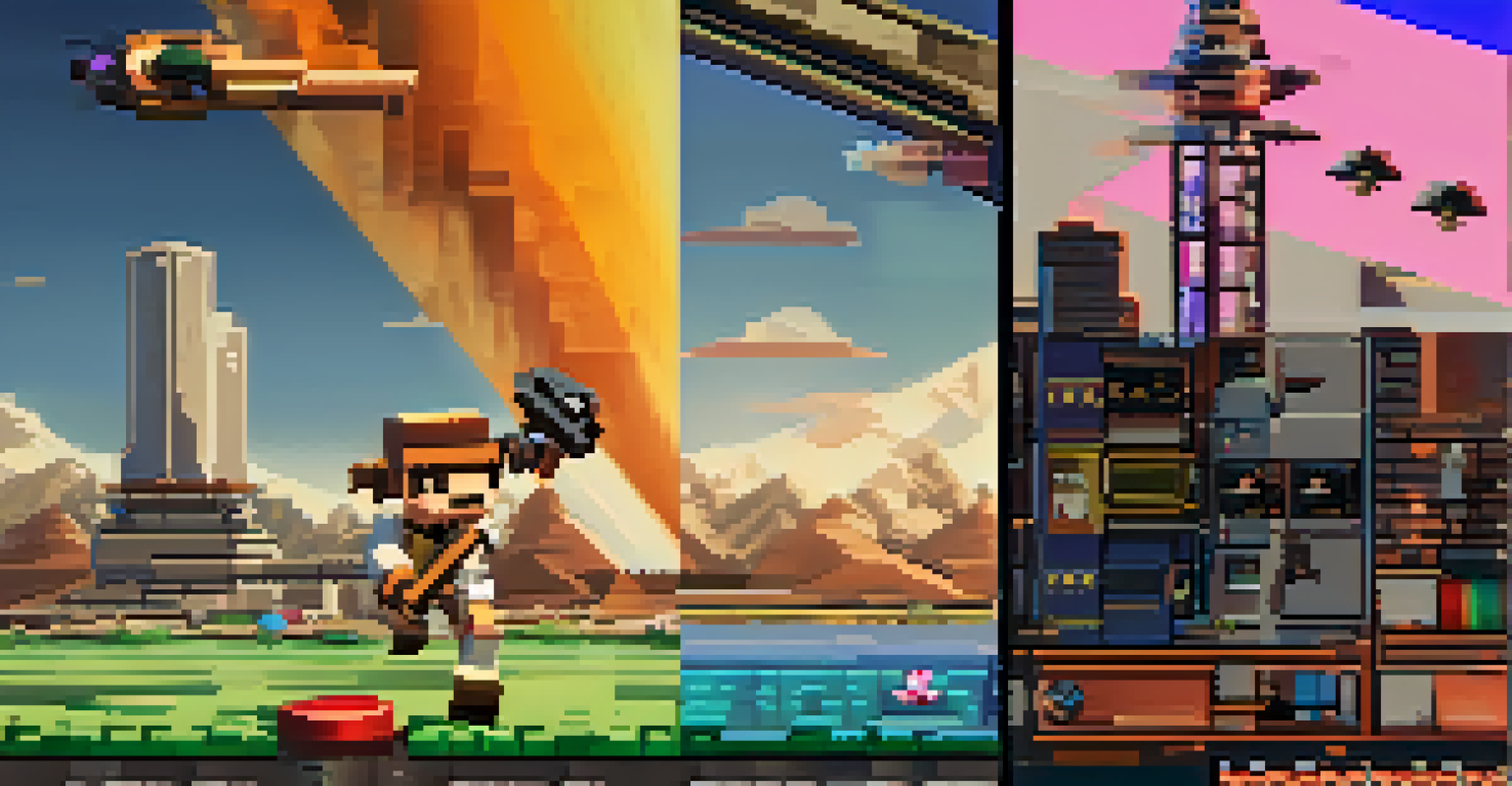From Pixels to Screen: The Art of Adapting Video Games

Understanding the Video Game Narrative Landscape
Video games are known for their rich storytelling, often immersing players in intricate narratives. Each game has a unique narrative structure, which can range from linear storylines to open-world explorations. This complexity presents a challenge when adapting them into films, as filmmakers must decide which elements to highlight while remaining true to the essence of the game.
Video games are a storytelling medium that is distinct from film, and as such, they require a different approach to adaptation.
For example, games like 'The Last of Us' weave deep emotional arcs with character development, making them ripe for cinematic exploration. However, the challenge lies in translating interactive storytelling into a passive viewing experience. Filmmakers must strike a balance between maintaining the game's spirit and crafting a coherent story for the screen.
Ultimately, understanding the narrative landscape of video games is crucial for any successful adaptation. It requires a deep appreciation of the source material and a keen sense of how to convey its core themes and character journeys through a different medium.
The Challenges of Faithfulness vs. Creativity
Adapting video games into films often sparks debates about faithfulness to the source material. Fans of the games usually have high expectations, hoping to see their favorite characters and storylines faithfully represented. However, filmmakers also want to inject their own creative vision into the project, which can lead to tensions between staying true to the game and exploring new narrative avenues.

Take the film adaptation of 'Resident Evil,' for example. While it introduced new characters and plotlines, it diverged significantly from the original game's story. This approach attracted a different audience but alienated some die-hard fans who preferred the game’s established narrative.
Balancing Faithfulness and Creativity
Successful video game adaptations require filmmakers to find a balance between staying true to the source material and infusing their own creative vision.
Thus, striking a balance between respecting the original material and allowing for creative freedom can be a tightrope walk for filmmakers. It's essential to find a middle ground that honors the game's legacy while also appealing to a broader cinematic audience.
Character Development: From Pixels to Performance
Character development is a fundamental aspect of both video games and films. In games, players often form emotional connections with characters through interactive experiences, making the transition to film a delicate process. A film must encapsulate these relationships in a way that resonates with viewers who may not have played the game.
The challenge is to retain the essence of the game while crafting a narrative that resonates with a broader audience.
For instance, the adaptation of 'Sonic the Hedgehog' showcased a character that was initially unrecognizable to fans. The filmmakers took fan feedback into account, ultimately redesigning Sonic to better reflect the beloved character. This demonstrates the importance of understanding character essence and audience expectations in adaptations.
In the end, translating character development from pixels to performance requires careful consideration of both the game’s portrayal and the film’s narrative demands. The goal is to create relatable characters that evoke empathy, ensuring that both gamers and new audiences can connect with them on screen.
Visual Style: Bridging the Gap Between Worlds
The visual style of a video game often plays a crucial role in its identity. When adapting a game into a film, filmmakers face the challenge of translating vibrant graphics and unique art styles into a live-action or animated format. This can involve making choices about color palettes, set designs, and overall aesthetic to capture the game's essence.
Take 'Assassin's Creed,' for example. The film aimed to recreate the game's historical settings and intricate designs, but the transition from animated environments to real-world filming posed significant challenges. The result was a visually striking film, yet it struggled to fully capture the immersive experience that players enjoyed in the game.
Character Development Matters
Translating character development from games to films is essential for creating relatable figures that resonate with both gamers and new audiences.
Ultimately, achieving a cohesive visual style that resonates with both gamers and film enthusiasts is essential for a successful adaptation. It requires a deep understanding of the game's artistry while also considering the practicalities of film production.
Soundscapes: Enhancing Emotion and Atmosphere
In video games, soundscapes play a vital role in enhancing the player's experience. From atmospheric background music to character sound effects, audio elements contribute significantly to immersion. When adapting a game into a film, filmmakers must carefully consider how to translate these auditory experiences to heighten emotional impact.
For instance, the 'Final Fantasy' film adaptations often incorporate the iconic music from the games, which resonates with fans and adds an emotional layer to the storytelling. This connection between sound and nostalgia can help bridge the gap between the game and the film experience.
Ultimately, soundscapes are not just an afterthought in film adaptations; they are a crucial component that can enrich the narrative and emotional depth. By thoughtfully integrating music and sound effects, filmmakers can create a more immersive experience for viewers.
Fan Engagement: Building Bridges Between Mediums
Fan engagement is a critical aspect of any successful video game adaptation. The gaming community is passionate and vocal, often expressing their expectations and desires for how their favorite games should be represented on screen. Filmmakers who actively engage with fans can build anticipation and ensure that their adaptations resonate with the audience.
Take the 'Pokémon Detective Pikachu' film as an example. The film's creators interacted with fans during the production process, incorporating elements that appealed to both long-time players and newcomers. This engagement helped create a sense of excitement and loyalty among fans, ultimately contributing to the film's success.
Fan Engagement is Key
Actively engaging with fans during the adaptation process helps filmmakers build anticipation and ensure the final product resonates with the audience.
Incorporating fan feedback and fostering community engagement can create a bridge between the game and its film adaptation. This connection not only honors the source material but also cultivates a shared experience among audiences, enhancing the overall appreciation for both mediums.
The Future of Video Game Adaptations in Film
As video games continue to gain popularity, the landscape of film adaptations is evolving. With advancements in technology and storytelling techniques, filmmakers have more tools at their disposal to create compelling adaptations. This opens up exciting possibilities for translating the rich worlds of video games onto the big screen.
Recent successes like 'The Witcher' series on Netflix and the 'Uncharted' film showcase how well-crafted adaptations can resonate with both gamers and general audiences. These projects demonstrate that when done thoughtfully, video game adaptations can achieve critical and commercial success.

Looking ahead, the future of video game adaptations in film holds immense potential. As filmmakers continue to experiment and innovate, we can expect to see more creative interpretations that honor the source material while captivating a wider audience. The journey from pixels to screen is just beginning, and it promises to be an exciting ride.